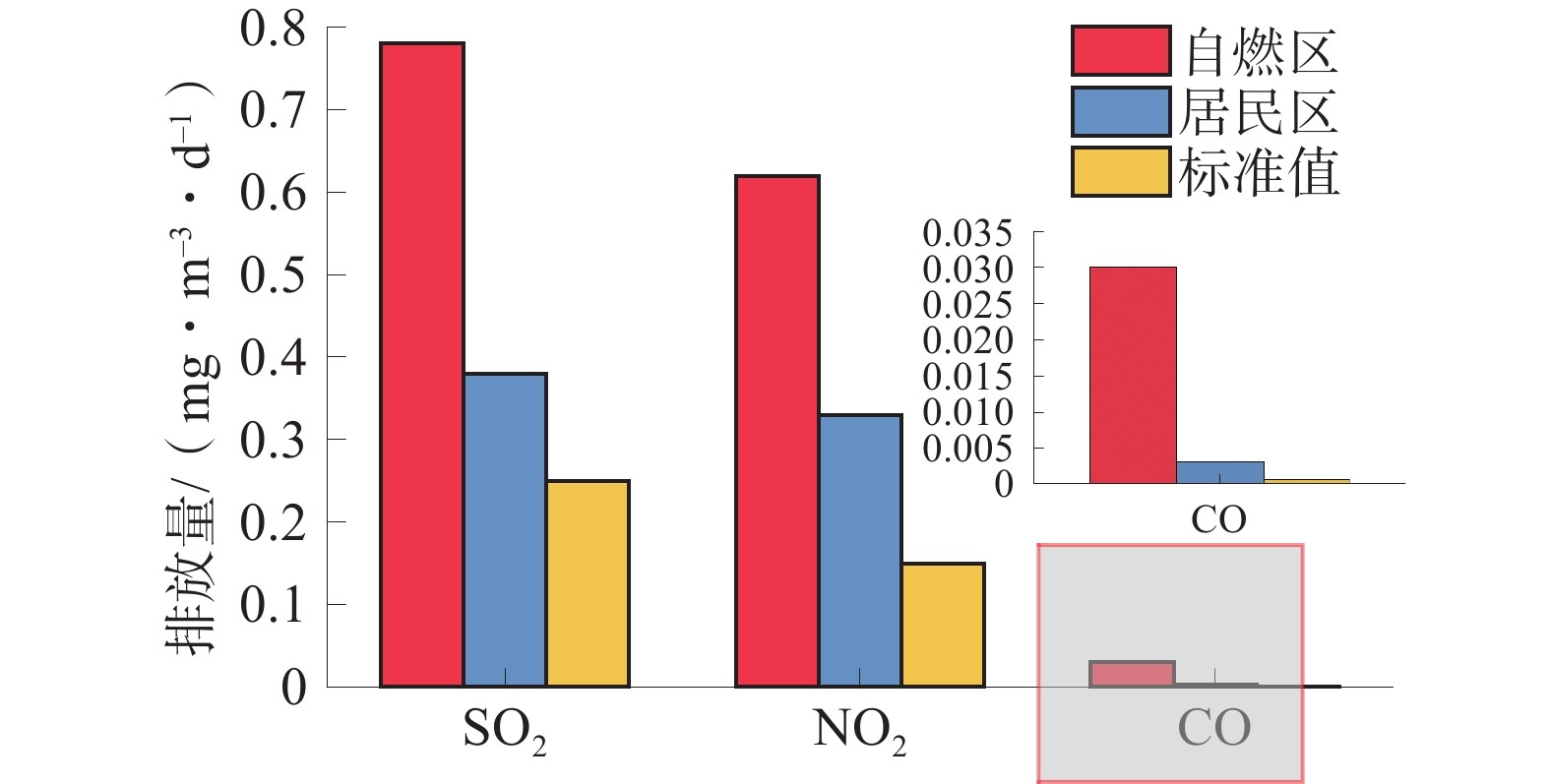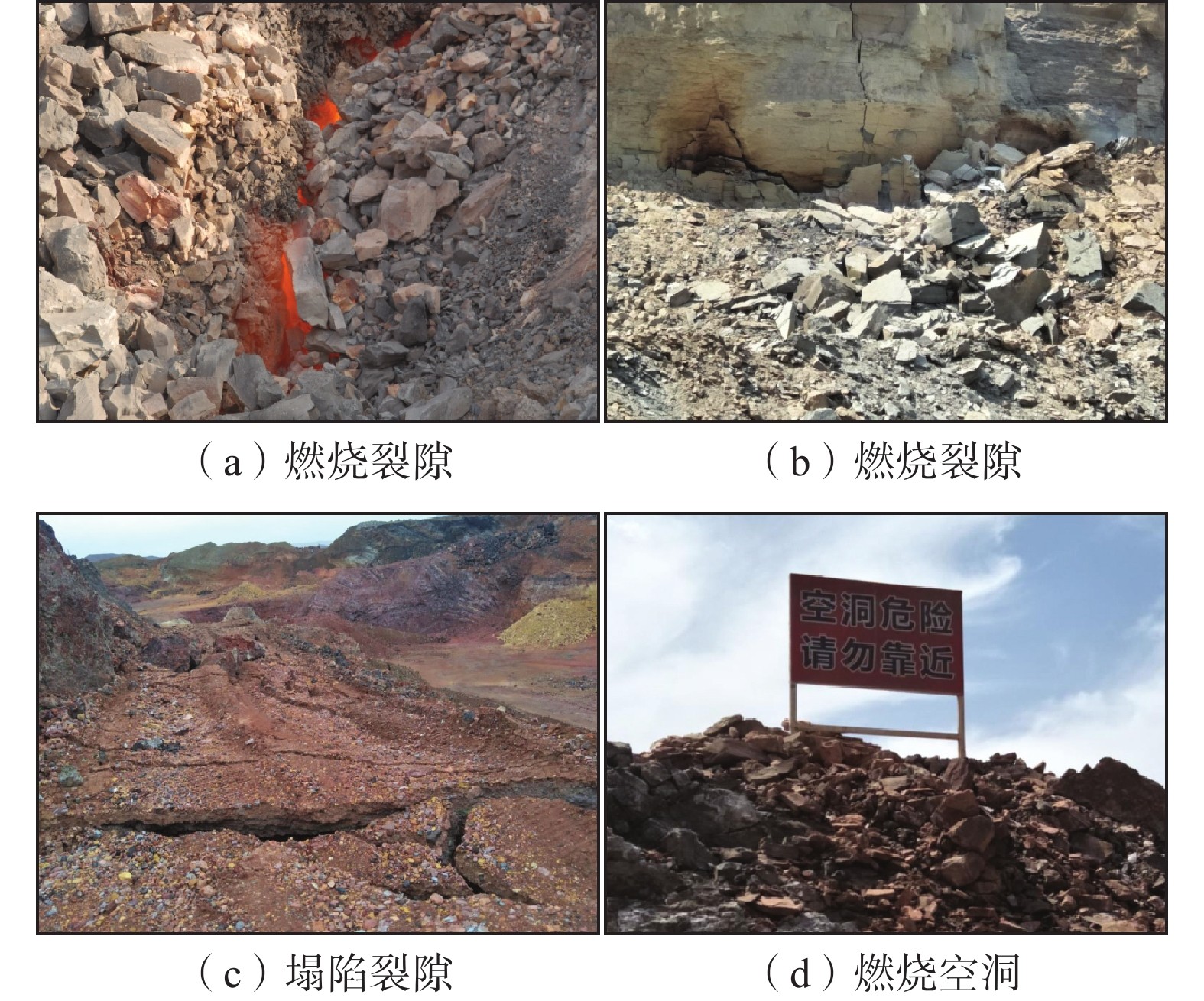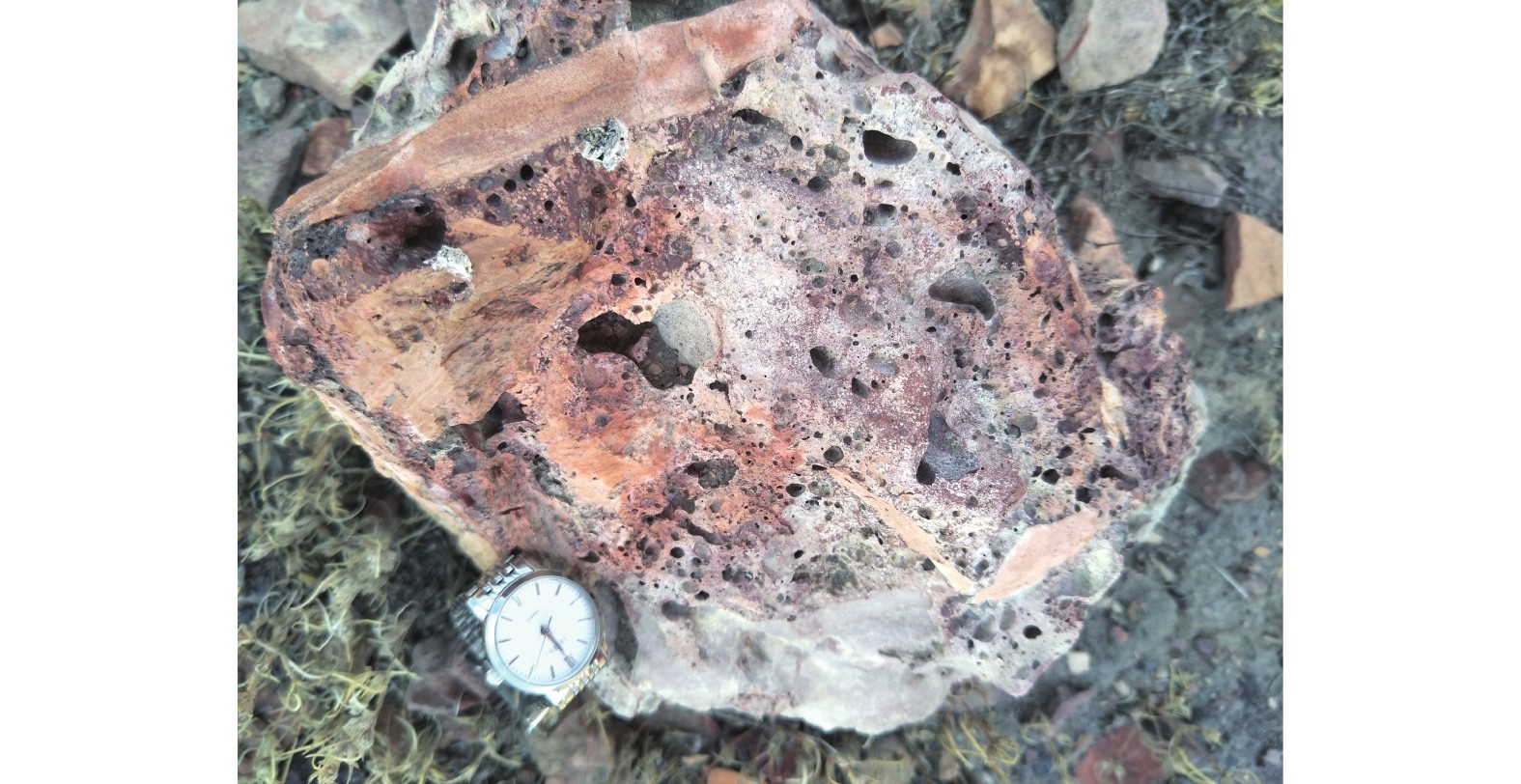Analysis of the influence of coal field fire on environment
-
摘要:
煤田自燃造成煤炭资源浪费、环境污染、人员伤亡、经济损失等问题。为了进一步推进对煤田自燃过程中对环境问题的关注,通过文献综述和野外地质调查等手段分析了煤田自燃过程对环境的影响,对比分析了温室气体的评估方法,介绍了有毒有害气体(SOx、NOx、有机物、Hg、HF)和气溶胶对火区及周边环境的影响,分析了煤火对土地资源及地表植被的破坏情况,探讨了煤自燃对水质的影响;从地质角度分析了煤火导致的地质灾害和烧变岩诱发的地质条件的变化。结合煤炭安全绿色智能化开采和清洁高效低碳集约化利用为主的发展趋势,对温室气体和有毒有害气体的排放量、土壤和水体污染物评价指标、地质灾害的预测和预报机制及烧变岩的特征节约水资源提出了工作展望。
Abstract:Coalfield spontaneous combustion causes problems such as wastage of coal resources, environmental pollution, casualties, and economic losses. In order to further promote attention to environmental issues during the process of coalfield spontaneous combustion, this paper analyzes the impact of coalfield spontaneous combustion on the environment through literature review and field geological investigation, compares and analyzes greenhouse gas assessment methods, introduces the effects of toxic and harmful gases (SOx, NOx, organic matter, Hg, HF) and aerosols on fire areas and surrounding environment, analyzes the damage caused by coal fires to land resources and surface vegetation, explores the impact of coal self-ignition on water quality, and analyzes from a geological perspective the geological disasters caused by coal fires and changes in geological conditions induced by burnt rocks. Combining with the development trend of safe, green, intelligent mining of coal and clean, efficient, low-carbon intensive utilization, the next step is to propose work prospects for reducing greenhouse gas and toxic and harmful gas emissions, evaluating soil and water pollutants, predicting and forecasting geological disasters, and characterizing burnt rocks to save water resources.
-
表 1 温室气体排放计算的相关方法
Table 1 Methods for calculating greenhouse gas emissions
排放量计算方法 参数说明 研究区 排放量 参考文献
$ \text{PEE}{\text{F}}_{{y}}=\displaystyle\sum {{F}}_{{iy}}\times\text{COEF}_i $$\text{PEE}{\text{F}}_{{y}} $为燃烧化石燃料排放的CO2,t;$\sum {{F}}_{{iy}} $年度内燃料i的消耗量,t;COEFi为燃料i的CO2的排放因子。 — — UNFCCC[15]
$ {{E}}_{\text{CO}_{2}\text{,fuel}}{={\mathrm{FC}}\times {\mathrm{EF}}} $${{E}}_{\text{CO}_{2}\text{,fuel}} $为燃料类型划分的CO2排放量,kg;FC为燃料的燃烧量,TJ;
EF为按燃料类型划分的CO2默认排放系数,kg/TJ 。— — IPCC[16]
$ {C=}\displaystyle\sum {{A}}_{{i}}{{S}}_{{i}}{{F}}_{{i}}{t} $
(i=1,2,···,m)C为碳排放量,t;Ai为i 火区的排放因子;Si为i火区面积,km2;
Fi为排放通量-单位时间单位面积火区的碳排放量,t/( s·km2);
t为估算时间间隔。乌达煤田 CO2 37.9×104 t/a 曹代勇等[22]
$C=\displaystyle\sum {{\alpha}}_{{i}}{{K}}_{{i}}{{M}}_{{i}} $α为排放系数;K为释放因子, t/(t·a);M为烧失煤量,t;
i为火区序列号。乌达煤田 CO2 4.95×104 t
2013年数据曹代勇等[23]
$ {C=}\displaystyle\sum {{\beta}}_{{i}}{{F}}_{{i}}{{S}}_{{i}} $β为排放系数;F为排放通量,mg/(s·m2);S为火区面积, m2。 乌达煤田 CO2 4.10×104 t
2013年数据曹代勇等[23] $ {F}_{g}=\dfrac{\text{1}}{\varPhi_{g}} \rho_{{h}} k {{U}}^{{*}} H \dfrac{\text{∂}{{\bar c}}_{{g}}}{\text{d}H} $ Fg为待测气体的通量密度,mg /( m2·s);Φg为大气稳定度调整系数;
ρh为监测高度处空气密度,mg /m3;k为卡曼常数,k= 0.035;
U*为摩擦风速;H为测量高度;cg为待测气体的质量浓度,mg /m3。活鸡兔火区 CO2 3.88~30.46
mg /( m2·s)陈晓坤等[28]
$ {{E}}_{{i}}{=}{{C}}_{{i}}{vA} $Ei为气体i排放的排放量;Ci为气体i在排气口的浓度;
v为垂直于排气口处气体的速度;A为排气口的横截面积。肯塔基州 CO2 65.69 t/a
CH4 5.73 t/aHOWER等[24]
$ {Q}_{ij}={Q}_{j} {C}_{ij} $Qij为烟气中i成分在j裂隙中的排放量,m3;Qj为第j裂隙中的烟气总流量,m3/s;Cij为第i成分在第j裂隙中占总流量的百分比,%。 水西沟南火区 CO2 3.7×108 m3/a 布威萨热·库尔班[32]
$ {T=V \rho g }W $为煤炭因燃烧的有效损失量;V为燃烧塌陷区立体模型的体积;
$\rho $为煤的密度;W为下沉系数。— — 徐友友等[30]
$ {{E}}_{{{\mathrm{CO}}_2}}=K M r $${{E}}_{{{\mathrm{CO}}_2}} $为碳排放量, t;K为CO2释放因子,g/(t.s);
M为原煤烧失煤量,t;r为排放率,%。乌达煤田 CO2 4.00×105 t 陈堔[31] -
[1] 谢和平,吴立新,郑德志. 2025年中国能源消费及煤炭需求预测[J]. 煤炭学报,2019,44(7):1949−1960. XIE Heping, WU Lixin, ZHENG Dezhi. Prediction on the energy consumption and coal demand of China in 2025[J]. Journal of China Coal Society, 2019, 44(7): 1949−1960.
[2] 中华人民共和国国家统计局. 中国统计年鉴2022[M]. 北京:中国统计出版社,2022:274-277. [3] 武晓娟. “十四五”能源转型要立足煤炭[N]. 中国能源报,2019−07−08(16). [4] 管海晏. 中国北方煤田自燃环境调查与研究[M]. 北京:煤炭工业出版社,1998:1-5,52-55. [5] 张建民. 中国地下煤火研究与治理[M]. 北京:煤炭工业出版社,2008:1−10. [6] 武建军,刘晓晨,蒋卫国,等. 新疆地下煤火风险分布格局探析[J]. 煤炭学报,2010,35(7):1147−1154. WU Jianjun, LIU Xiaochen, JIANG Weiguo, et al. Spatial analysis of risk for underground coal fire in Xinjiang, China[J]. Journal of China Coal Society, 2010, 35(7): 1147−1154.
[7] 张渝. 煤自燃的微观理化特性和宏观特征研究[D]. 北京:中国矿业大学(北京),2019. [8] 贺强. 双碳目标下我国西部地区地下煤火探测技术研究进展[J]. 中国煤炭地质,2022,34(4):8−13. HE Qiang. Research progress of underground coal fire detection technology in Western China under carbon peaking and carbon neutrality goals[J]. Coal Geology of China, 2022, 34(4): 8−13.
[9] 胡社荣,蒋大成. 煤层自燃灾害研究现状与防治对策[J]. 中国地质灾害与防治学报,2000,11(4):69−72. HU Sherong, JIANG Dacheng. The disaster of spontaneous combustion of coalbeds and countermeasure of prevention[J]. The Chinese Journal of Geological Hazard and Control, 2000, 11(4): 69−72.
[10] 胡社荣,蒋大成,李泽光,等. 煤田煤矿区火灾与环境效应及其防治对策[J]. 地质灾害与环境保护,2001,12(1):21−23. HU Sherong, JIANG Dacheng, LI Zeguang, et al. The fire in coalfield and coal mine and its environment effect and prevention control[J]. Journal of Geological Hazards and Environment Preservation, 2001, 12(1): 21−23.
[11] 曹代勇,时孝磊,樊新杰,等. 煤田火区环境效应分析[J]. 中国矿业,2007,16(7):40−42. doi: 10.3969/j.issn.1004-4051.2007.07.013 CAO Daiyong, SHI Xiaolei, FAN Xinjie, et al. Environmental effect analysis of coalfield fire[J]. China Mining Magazine, 2007, 16(7): 40−42. doi: 10.3969/j.issn.1004-4051.2007.07.013
[12] 曹代勇,时孝磊. 煤田火区环境影响综合评价指标体系与评价方法[J]. 地球科学与环境学报,2009,31(1):94−99. CAO Daiyong, SHI Xiaolei. Study on the index system and method for comprehensively assessing the environmental impact of coalfield fires[J]. Journal of Earth Sciences and Environment, 2009, 31(1): 94−99.
[13] 马李洋. 煤火前沿贫氧燃烧动力学特性及煤焦分子结构转化机理[D]. 徐州:中国矿业大学,2020. [14] 外交部. 《联合国气候变化框架公约》进程[EB/OL]. (2020-10-20) [2021-01–04]. http://russiaembassy.fmprc.gov.cn/web/ziliao_674904/tytj_674911/tyfg_674913/t1201175.shtml. [15] GIELISCH H, KROPP C. Coal fires a major source of greenhouse gases-a forgotten problem[J]. Environmental Risk Assessment and Remediation, 2018, 2(1): 5−8.
[16] Intergovernmental Panel on Climate Change, IPCC. Chapter 2: Stationary combustion. In Darío R. Gómez, John D. Watterson, Branca B. Americano, et al. (Eds.), 2006 IPCC Guidelines for National Greenhouse Gas Inventories (Vol. 2): Energy[R]. Hayama, Kanagawa, Japan: IPCC, 2006.
[17] ENGLE M A, RADKE L F, HEFFERN E L, et al. Gas emissions, minerals, and tars associated with three coal fires, Powder River Basin, USA[J]. Science of the Total Environment, 2012, 420: 146−159. doi: 10.1016/j.scitotenv.2012.01.037
[18] ENGLE M A, RADKE L F, HEFFERN E L, et al. Quantifying greenhouse gas emissions from coal fires using airborne and ground-based methods[J]. International Journal of Coal Geology, 2011, 88(2/3): 147−151.
[19] CARRAS J N, DAY S J, SAGHAFI A, et al. Greenhouse gas emissions from low-temperature oxidation and spontaneous combustion at open-cut coal mines in Australia[J]. International Journal of Coal Geology, 2009, 78(2): 161−168. doi: 10.1016/j.coal.2008.12.001
[20] WANG H Y, CHEN C, HUANG T, et al. CO2 emission of coal spontaneous combustion and its relation with coal microstructure, China[J]. Journal of Environmental Biology, 2015, 36(4): 1017−1024.
[21] VAN DIJK P, ZHANG J Z, JUN W, et al. Assessment of the contribution of in situ combustion of coal to greenhouse gas emission; based on a comparison of Chinese mining information to previous remote sensing estimates[J]. International Journal of Coal Geology, 2011, 86(1): 108−119. doi: 10.1016/j.coal.2011.01.009
[22] 曹代勇,杨光,豆旭谦,等. 基于遥感技术的内蒙古乌达煤田火区碳排放计算[J]. 煤炭学报,2014,39(12):2489−2494. CAO Daiyong, YANG Guang, DOU Xuqian, et al. Calculation of carbon emission of Wuda Coalfield fires in Inner Mongolia based on remote sensing technology[J]. Journal of China Coal Society, 2014, 39(12): 2489−2494.
[23] 曹代勇,刘志飞,杨光,等. 煤田火区碳排放量计算模型和关键参数研究[J]. 地学前缘,2018,25(1):252−258. CAO Daiyong, LIU Zhifei, YANG Guang, et al. Models for estimating carbon dioxide emission from coalfield fires and the study of the related key parameters[J]. Earth Science Frontiers, 2018, 25(1): 252−258.
[24] HOWER J C, O’KEEFE J M K, HENKE K R, et al. Gaseous emissions and sublimates from the Truman Shepherd coal fire, Floyd County, Kentucky: A re-investigation following attempted mitigation of the fire[J]. International Journal of Coal Geology, 2013, 116: 63−74.
[25] Intergovernmental Panel on Climate Change, IPCC. Chapter 3: Mobile combustion. In Christina Davies Waldron, JochenHarnisch. OswaldoLucon, et al. (Eds. ), 2006 IPCC Guidelines for National Greenhouse Gas Inventories (Vol. 2): Energy[R]. Hayama, Kanagawa, Japan, 2006.
[26] Intergovernmental Panel on Climate Change, IPCC. Chapter 4: Fugitive emissions. In John N. Carras, Pamela M. Franklin, Yuhong Hu, et al. (Eds. ), 2006 IPCC Guidelines for National Greenhouse Gas Inventories (Vol. 2): Energy[R]. Hayama, Kanagawa, Japan, 2006.
[27] HOWER J C, HENKE K, O’KEEFE J M K, et al. The Tiptop coal-mine fire, Kentucky: Preliminary investigation of the measurement of mercury and other hazardous gases from coal-fire gas vents[J]. International Journal of Coal Geology, 2009, 80(1): 63−67. doi: 10.1016/j.coal.2009.08.005
[28] 陈晓坤,桑长波,马砺,等. 煤田火区温室气体排放通量及其影响因素研究[J]. 中国安全生产科学技术,2016,12(4):15−19. CHEN Xiaokun, SANG Changbo, MA Li, et al. Study on emission flux of greenhouse gas in coalfield fire area and its influencing factors[J]. Journal of Safety Science and Technology, 2016, 12(4): 15−19.
[29] 陈晓坤,桑长波,李珍宝. 煤田火区有害气体排放的环境影响评估方法研究[J]. 安全与环境工程,2016,23(2):55−59. CHEN Xiaokun, SANG Changbo, LI Zhenbao. Environment impact assessment method of harmful gas emission in coalfield fire area[J]. Safety and Environmental Engineering, 2016, 23(2): 55−59.
[30] 徐友友,郭广礼,李怀展. 乌达煤田自燃煤炭损失量的估算方法[J]. 煤炭科学技术,2018,46(11):88−92. XU Youyou, GUO Guangli, LI Huaizhan. Method to estimate coal loss of spontaneous combustion in WudaCoalfield[J]. Coal Science and Technology, 2018, 46(11): 88−92.
[31] 陈琛. 煤自燃过程中温室气体排放的量化实验研究[D]. 北京:中国矿业大学(北京),2016. [32] 威萨热·库尔班. 煤火典型污染物排放特征研究[D] . 乌鲁木齐:新疆大学,2013. [33] 田晶晶. 山西省煤层自燃危害及环境影响研究[J]. 节能与环保,2020(4):77−78. doi: 10.3969/j.issn.1009-539X.2020.04.033 TIAN Jingjing. Study on the harm and environmental impact of coal seam spontaneous combustion in Shanxi[J]. Energy Conservation & Environmental Protection, 2020(4): 77−78. doi: 10.3969/j.issn.1009-539X.2020.04.033
[34] 罗淑政. 煤火废弃地的生态恢复研究−以内蒙古乌达矿区为例[D]. 乌鲁木齐:新疆大学,2009. [35] 马双. 基于AHP的大同矿区煤层自燃地质灾害研究[D]. 太原:太原理工大学,2014. [36] 赵京茹. 煤矸石中多环芳烃的分布及其在自燃过程中的析出特征[D]. 太原:太原理工大学,2019. [37] 梁言慈. 内蒙古乌达煤火典型污染物排放特征研究[D]. 北京:中国矿业大学(北京),2018. [38] 孙殿军,沈雁峰,赵新华,等. 中国大陆地方性氟中毒病情动态与现状分析[J]. 中国地方病学杂志,2001,20(6):429−433. SUN Dianjun, SHEN Yanfeng, ZHAO Xinhua, et al. Analysis on the disease trend and present state of endemic fluorosis in China mainland[J]. Chinese Jouranl of Endemiology, 2001, 20(6): 429−433.
[39] 成娜,彭林,牟玲,等. 山西煤层自燃区PM10中有机碳、元素碳的特征[J]. 中国环境科学,2015,35(1):40−44. CHENG Na, PENG Lin, MU Ling, et al. Characterization of atmospheric organic and elemental carbon of PM10 in coal spontaneous combustion zone, Shanxi[J]. China Environmental Science, 2015, 35(1): 40−44.
[40] 董敬宣. 准南煤田乌鲁木齐大泉湖火区监测研究[D]. 乌鲁木齐:新疆大学,2018. [41] 倪绍忠,师庆东,王涛. 基于乡土材料在煤田灭火区土壤改良中的应用研究[J]. 安徽农业科学,2013,41(6):2434−2435. NI Shaozhong, SHI Qingdong, WANG Tao. Application of local material in soil improvement of coalfield fire[J]. Journal of Anhui AgriculturalSciences, 2013, 41(6): 2434−2435.
[42] 胡雯,张涛,廖先燕,等. 地下煤火不同燃烧阶段上覆土壤微生物群落功能多样性[J]. 新疆农业科学,2012,49(3):515−522. doi: 10.6048/j.issn.1001-4330.2012.03.018 HU Wen, ZHANG Tao, LIAO Xianyan, et al. Functional diversity of soil microbial community in different combustion periods of underground coal mine fire[J]. Xinjiang Agricultural Sciences, 2012, 49(3): 515−522. doi: 10.6048/j.issn.1001-4330.2012.03.018
[43] 徐卫东,陈润羊. 煤矸石的环境水文地质作用模式研究[J]. 洁净煤技术,2006,12(3):108−112. XU Weidong, CHEN Runyang. Researching the environment hydrology function mode of the coal-gangue[J]. Clean Coal Technology, 2006, 12(3): 108−112.
[44] 曾强,塔西甫拉提·特依拜,Manfred W. Wuttke,等. 地下煤火土壤重金属分布特征及其污染评价[J]. 中国矿业大学学报,2014,43(4):695−700. ZENG Qiang, TASHPOLAT·Tiyip, MANFRED W. Wuttke, et al. Characteristics of the heavy metal distribution in the soils of underground coal fire and the evaluation of its impact on environment[J]. Journal of China University of Mining & Technology, 2014, 43(4): 695−700.
[45] 曾强,聂静,蒲燕. 地下煤火土壤典型重金属分布特征[J]. 煤炭学报,2016,41(8):1989−1996. ZENG Qiang, NIE Jing, PU Yan. Characteristics of the distribution of typical heavy metals in the soils of underground coal fire[J]. Journal of China Coal Society, 2016, 41(8): 1989−1996.
[46] 陈晶. 淮南矿区环境中多环芳烃分布赋存规律及环境影响[D]. 北京:中国地质大学(北京),2005. [47] 樊景森,孙玉壮,牛红亚,等. 九龙煤矿煤矸石山对环境的有机污染[J]. 环境污染与防治,2009,31(1):101−103. doi: 10.3969/j.issn.1001-3865.2009.01.027 FAN Jingsen, SUN Yuzhuang, NIU Hongya, et al. Organic pollution of Jiulong Mine coal gangue on the environment[J]. Environmental Pollution and Control, 2009, 31(1): 101−103. doi: 10.3969/j.issn.1001-3865.2009.01.027
[48] 张红. 西山杜儿坪矿煤矸石中元素与多环芳烃的地球化学特征研究[D]. 太原:太原理工大学,2012. [49] 姜楠,杨锋杰,孟彦如,等. 煤矸石自燃过程中多环芳烃含量的变化研究[J]. 工业安全与环保,2015,41(4):69−72. JIANG Nan, YANG Fengjie, MENG Yanru, et al. Study on polycyclic aromatic hydrocarbons(PAHs) content changing of coal gangue during spontaneous combustion[J]. Industrial Safety and Environmental Protection, 2015, 41(4): 69−72.
[50] 王晓娟,文雪琴,杨凯. 杜儿坪矿自燃矸石中多环芳烃的含量及分布特征[C]//《环境工程》2018年全国学术年会论文集(中册). 北京:中国环境科学出版社,2018:309−312. [51] 张学庆,张渝,于明达,等. 新疆煤田火区的危害与治理挑战[J]. 中国矿业,2014,23(S2):93−95. ZHANG Xueqing, ZHANG Yu, YU Mingda, et al. Damages and cellenge for governing of coalfield fires in Xinjiang[J]. China Mining Magazine, 2014, 23(S2): 93−95.
[52] 李燕. 基于多光谱遥感的煤层自燃对土地资源的影响研究[D]. 太原:太原理工大学,2014. [53] 张渝,杨雯. 煤火燃烧阶段的划分及其特征分析[J]. 煤炭技术,2017,36(6):151−153. ZHANG Yu, YANG Wen. Coal fire burning stage division and its characteristic analysis[J]. Coal Technology, 2017, 36(6): 151−153.
[54] 莫爱,杨建军,周耀治. 西沟煤矿煤火废弃地土壤种子库与地上植被关系研究[J]. 生态科学,2016,35(2):66−74. MO Ai, YANG Jianjun, ZHOU Yaozhi. Relationship between soil seed bank and standing vegetation of abandoned coal fire area in Xigou coal mine[J]. Ecological Science, 2016, 35(2): 66−74.
[55] 杨建军,莫爱,刘巍,等. 乌鲁木齐松树头煤田火区植被恢复的物种筛选[J]. 生态学杂志,2015,34(6):1499−1506. YANG Jianjun, MO Ai, LIU Wei, et al. Screening plant species for revegetation on the coal fire wasteland in Songshutou, Urumqi[J]. Chinese Journal of Ecology, 2015, 34(6): 1499−1506.
[56] 杜川,梁汉东,李展平. 内蒙古乌达煤火海绵体的硫酸盐表征[J]. 环境化学,2020,39(1):264−270. doi: 10.7524/j.issn.0254-6108.2019020701 DU Chuan, LIANG Handong, LI Zhanping. Characterization of sulfate salts in the coal fire sponge in WudaCoalfield, Inner Mongolia of China[J]. Environmental Chemistry, 2020, 39(1): 264−270. doi: 10.7524/j.issn.0254-6108.2019020701
[57] 高鹏. 乌达煤田煤火海绵体多环芳烃污染评价[J]. 内蒙古煤炭经济,2019(11):40−41. doi: 10.3969/j.issn.1008-0155.2019.11.018 GAO Peng. Evaluation of polycyclic aromatic hydrocarbons pollution in coal fire Caverns in WUDA coalfield[J]. Inner Mongolia Coal Economy, 2019(11): 40−41. doi: 10.3969/j.issn.1008-0155.2019.11.018
[58] 曹远远,陈飞. 乌鲁木齐大泉湖煤田自燃特征及环境影响[J]. 山东煤炭科技,2017,35(5):110−112. doi: 10.3969/j.issn.1005-2801.2017.05.049 CAO Yuanyuan, CHEN Fei. Spontaneous combustion characteristics and environmental effects of Daquanhu Coalfield in Urumqi[J]. Shandong Coal Science and Technology, 2017, 35(5): 110−112. doi: 10.3969/j.issn.1005-2801.2017.05.049
[59] 李艳英. 洗煤水治理矸石山自燃对地下水的影响研究[J]. 煤矿环境保护,2000,14(4):29−30. LI Yanying. Study on influence of treating coal gangue sportaneous combustion to groundwater with coal dressing water[J]. Energy Environmental Protection, 2000, 14(4): 29−30.
[60] ZHAO Z B, LIU K L, XIE W, et al. Soluble polycyclic aromatic hydrocarbons in raw coals[J]. Journal of Hazardous Materials, 2000, 73(1): 77−85. doi: 10.1016/S0304-3894(99)00178-8
[61] 敖卫华. 内蒙古乌达矿区煤矸石中有害物质环境地球化学效应研究[D]. 北京:中国地质大学(北京),2005. [62] 齐德香. 新疆煤田火灾的危害及其防治[J]. 中国煤炭,2005,31(6):34−36. QI Dexiang. The harm of fire accidents in Xinjiang coal field and its preventive and control method[J]. China Coal, 2005, 31(6): 34−36.
[63] 齐俊德,禹学成. 浅谈宁夏煤田火灾现状及综合治理[J]. 陕西煤炭,2007,26(1):36−38. QI Junde, YU Xuecheng. Present situation and comprehensive treatment of fire accident in Ningxia coal-field[J]. Shaanxi Coal, 2007, 26(1): 36−38.
[64] 曹代勇,樊新杰,吴查查,等. 内蒙古乌达煤田火区相关裂隙研究[J]. 煤炭学报,2009,34(8):1009−1014. CAO Daiyong, FAN Xinjie, WU Chacha, et al. Study on the fractures related with coalfield fire area in WudaCoalfield, Inner Mongolia[J]. Journal of China Coal Society, 2009, 34(8): 1009−1014.
[65] 刘志坚. 论烧变岩的特征、成因及地下火燃烧的规律性[J]. 地质论评,1959,5(5):209−211. doi: 10.3321/j.issn:0371-5736.1959.05.005 [66] 刘长龄. 论烧变矿床与烧变岩研究及其意义[J]. 地质找矿论丛,1988,3(3):54−61. [67] 黄雷,刘池洋. 烧变岩岩石学及稀土元素地球化学特征[J]. 地球科学,2008,33(4):515−522. HUANG Lei, LIU Chiyang. Petrologic and REE geochemical characters of burnt rocks[J]. Earth Science, 2008, 33(4): 515−522.
[68] 黄雷,刘池洋. 鄂尔多斯盆地北部地区延安组煤层自燃烧变产物及其特征[J]. 地质学报,2014,88(9):1753−1761. HUANG Lei, LIU Chiyang. Products of combustion of the Yan’an Formation coal seam and their characteristics in the northeastern Ordos Basin[J]. Acta Geologica Sinica, 2014, 88(9): 1753−1761.
[69] 张渝,胡社荣,彭纪超,等. 中国北方煤层自燃产物分类及宏观模型[J]. 煤炭学报,2016,41(7):1798−1805. ZHANG Yu, HU Sherong, PENG Jichao, et al. Metamorphic products of coal combustion and its macroscopic models in North China[J]. Journal of China Coal Society, 2016, 41(7): 1798−1805.
[70] 赵德乾,王振伟,赵雪,等. 烧变岩剪切特性试验研究[J]. 露天采矿技术,2013(9):5−7. doi: 10.3969/j.issn.1671-9816.2013.09.003 ZHAO Deqian, WANG Zhenwei, ZHAO Xue, et al. Experimental study on burnt coal rock shear properties[J]. Opencast Mining Technology, 2013(9): 5−7. doi: 10.3969/j.issn.1671-9816.2013.09.003
[71] 田军,李海洲,夏冬. 新疆白砾滩露天煤矿烧变岩特征及边坡稳定性分析[J]. 煤矿安全,2013,44(7):223−225. TIAN Jun, LI Haizhou, XIA Dong. Burnt rock characteristics and slope stability analysis in Xinjiang Bailitan Open-pit Mine[J]. Safety in Coal Mines, 2013, 44(7): 223−225.
[72] 王振伟,王海洋,赵雪. 顺倾烧变岩边坡变形演化机理及稳定控制技术研究[C]//中国职业安全健康协会2013年学术年会论文集. 北京:煤炭工业出版社,2013:442−447. [73] 杨伟峰. 烧变岩石伺服条件下渗透特性试验研究[J]. 矿业研究与开发,2007,27(1):79−81. doi: 10.3969/j.issn.1005-2763.2007.01.028 YANG Weifeng. Experimental research on permeability of burnt rock under servo-control condition[J]. Mining Research and Development, 2007, 27(1): 79−81. doi: 10.3969/j.issn.1005-2763.2007.01.028
[74] 刘志伟. 陕北地区烧变岩的地质特性与工程性能分析[J]. 电力勘测设计,2005(2):27−30. doi: 10.3969/j.issn.1671-9913.2005.02.007 LIU Zhiwei. Geological characteristic analysis and engineering property of baked metamorphic rock in North Shanxi Region[J]. Electric Power Survey, 2005(2): 27−30. doi: 10.3969/j.issn.1671-9913.2005.02.007
[75] 杜中宁,党学亚,卢娜. 陕北能源化工基地烧变岩的分布特征及水文地质意义[J]. 地质通报,2008,27(8):1168−1172. DU Zhongning, DANG Xueya, LU Na. Distribution characteristics of burnt metamorphic rocks in the Northern Shaanxi Energy and Chemical Industry Base, China and their hydrogeological significance[J]. Geological Bulletin of China, 2008, 27(8): 1168−1172.
[76] 贺卫中. 烧变岩强富水区水害防治技术[C]//煤矿水害防治技术研究—陕西省煤炭学会学术年会论文集. 北京:煤炭工业出版社,2013:120−122. [77] 温成新,刘远军,何泽宏. 烧变岩钻孔与帷幕注浆技术在煤矿治水中的应用[J]. 能源技术与管理,2014,39(5):77−79. [78] 蒋泽泉. 榆神府矿区烧变岩及地下水资源特征[J]. 陕西煤炭,2005,24(4):20−21. doi: 10.3969/j.issn.1671-749X.2005.04.008 JIANG Zequan. Characteristics of fritted rock and groundwater resources in Yushenfu mining area[J]. Shaanxi Coal, 2005, 24(4): 20−21. doi: 10.3969/j.issn.1671-749X.2005.04.008




 下载:
下载:



